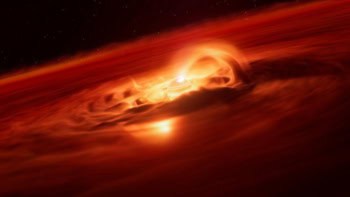
A new study of sunlight reflected from the Moon should quell any concern that the next generation of space telescopes may not be able to detect signs of life on Earth-like planets orbiting distant stars. That is the view of astronomers in Spain and the US, who have found that it is relatively easy to detect methane and other biologically-significant gases in our own planet by studying the sunlight passing through the Earth’s atmosphere during a lunar eclipse. The measurements raise hopes that NASA’s James Webb Space Telescope, due for launch in 2014, will find evidence for extraterrestrial life.
Astronomers have so far discovered almost 350 extrasolar planets (exoplanets), which orbit stars other than our own Sun. Most of these are “gas giants” similar to Jupiter and it is possible to study what their atmospheres contain if they happen to pass across (or transit) the line of sight between the star and Earth. Astronomers have had some success determining the chemical composition of the atmosphere of a few of these gas giants by studying how they absorb and transmit light.
However, Earth-like planets that could harbour life are much smaller than gas giants, with much less light passing through their atmospheres. Indeed, some computer simulations suggest that next-generation space telescopes such as the James Webb might not be able to detect signs of life — carbon dioxide, water, oxygen and methane — in the atmosphere of such ‘habitable’ exoplanets.
Prominent structures
But now Enric Pallé and colleagues at the Institute of Astrophysics of the Canaries and the University of Central Florida have — for the first time — analysed sunlight after it has passed through Earth’s atmosphere in a transit-like scenario.
The measurements were made during a lunar eclipse in 2008 when the Earth passed between the Moon and Sun — leaving the Moon in near darkness. When this occurred, a small amount of sunlight passed through Earth’s atmosphere, struck the Moon, and then returned to Earth. Some of this light was then collected by Pallé and colleagues on the Canary Islands using the William Herschel and Nordic Optical Telescopes.
The team found that the transmission spectrum for near infrared and visible light contained peaks and troughs corresponding to the presence of oxygen, water, carbon dioxide, and methane in the atmosphere. Although the signals themselves were no surprise, they were more prominent than many astronomers had expected. Indeed, Pallé told physicworld.com that when the team degraded the spectrum to what would be expected from a distant Earth-like exoplanet, the peaks could still be resolved.
Methane high
One unexpected finding is that the signal from methane is particularly high, which is surprising because methane is much less common in the atmosphere than oxygen, water, or even carbon dioxide. As a result, Pallé believes that future telescopes should be optimized to detect methane in addition to oxygen and water.
While the researchers are not certain why the peaks are stronger than many had expected, Pallé believes that it has to do with the very long path through the atmosphere taken by light as it travels tangentially to Earth’s surface. This distance is about 80 times the radial thickness of the atmosphere, and massive computer simulations (as yet unavailable) would be required to understand what happens as it travels such distances.
Exoplanet hunter Giovanna Tinetti of University College London described the research as a “strong and optimistic message” to astronomers planning to use next-generation instruments such as NASA’s James Webb Telescope to search the cosmos for signs of life. “It’s a good sign that we will be able to look at planets slightly larger than Earth,” she says.
Indeed, Tinetti believes that the Hubble Space Telescope could be used today to study a habitable planet transiting a relatively small star. But therein lies the rub — astronomers have yet to discover a suitable candidate for Hubble or even James Webb.
Pallé is optimistic though — he believes that by the time James Webb is working in 2014, the recently launched-Kepler mission will have discovered at least one suitable candidate.
The research is published in Nature.



